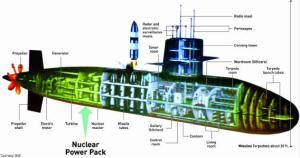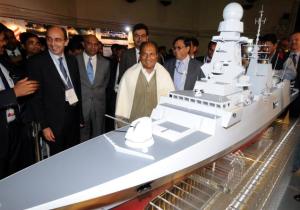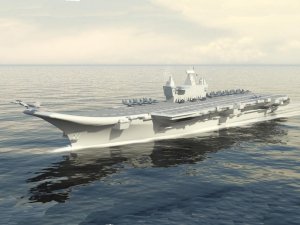 Kamorta class Corvettes are the Indian Navy’s next-generation anti submarine warfare platform, built under Project 28. They are being built at Garden Reach Shipbuilders and Engineers (GRSE), Kolkata. The first corvette is expected to be delivered to the Indian Navy in 2012. All the four corvettes are planned to be handed over to the Indian Navy by the year 2014.
Kamorta class Corvettes are the Indian Navy’s next-generation anti submarine warfare platform, built under Project 28. They are being built at Garden Reach Shipbuilders and Engineers (GRSE), Kolkata. The first corvette is expected to be delivered to the Indian Navy in 2012. All the four corvettes are planned to be handed over to the Indian Navy by the year 2014.
Project 28 is the primary project for driving indigenisation and developing the warship construction industry in India. The aim with this project is to stipulate unprecedented standards while providing opportunities to Indian vendors to develop expertise with the technology. The project, driven by the Navy’s Directorate of Indigenisation, has been delayed by two years with a cost overrun from the originally estimated INR 28 Billion to INR 70 Billion, primarily to meet this goal.
The order for the first four corvettes was placed in 2003, with construction commencing on August 12, 2005.
Design
The basic design for Project 28 was specified by the Indian Navy’s Directorate of Naval Design, with the detailed design by GRSE. The design includes many stealth features, including reductions in noise and vibration of the vessels.
Displacing around 3000 tons and a length of around 110 metres, these vessels will have a very high percentage of Indian made equipment – either designed indigenuously or built under license through technology transfer agreements.
The DMR 249A hull steel is produced locally by SAIL (Steel Authority of India Limited). The main machinery is raft mounted to reduce acoustic and vibration signatures. Each gear unit and the associated engines will be mounted on a common raft. The vessel will feature automated control and battle damage systems. The Project 28 vessels use diesel engines built by Pielstick of France. DCNS supplied the noise-suppressing raft-mounted gearbox for CODAD propulsion. Wärtsilä India will deliver the low-vibration diesel alternators to power the on-board electronics. Other signature management control features are built in to combat the ship’s infrared, radar-cross signature, noise and magnetic outputs. Two independent interconnected switchboards optimize redundancy and reliability.
It was announced on 21 December 2006 that GRSE awarded France’s DCNS a contract to provide a comprehensive engineering package of raft mounted Propulsion Power Transmission Systems (PPTS) for the four corvettes. Under the contract, DCNS will deliver four propulsion packages (consisting of eight reduction gear units on cradles and either thrust blocks) to GRSE. The company will also provide support to GRSE for the mechanical integration of the propulsion plant. DCNS is partnering with Walchandnagar Industries Limited, to provide the raft mounts and other components, including thrust blocks and systems auxiliaries. The first propulsion package was delivered in 2008, with the remaining three to follow at the rate of one per year until 2011.
Armament is to include a license-built Otobreda 76 mm Super Rapid gun in a stealth mount and the usual assortment of weapons similar to what is found on the Talwar class frigates and Shivalik class frigates including a Klub-N missile system in vertical launchers, two Larsen & Toubro built derivatives of the RBU-6000 anti-submarine rocket launcher, as well as Larsen & Toubro torpedo launchers. Revati, the naval variant of the DRDO-made Central Acquisition Radar (CAR), is a confirmed sensor aboard the vessel. Hangar and aviation facilities will also be standard features.
| overview | |
|---|---|
| Name: | Kamorta class corvette |
| Builders: | GRSE |
| Operators: |
Indian Navy |
| Preceded by: | Kora class |
| Succeeded by: | P-28A ASW Corvette |
| Cost: | INR 28-70 Billion |
| Built: | 2005- |
| In service: | 2012- |
| Building: | 4 |
| Planned: | 4 + 8 (project 28a) |
| Major characteristics | |
| Class and type: | Project 28 |
| Type: | ASW Corvette |
| Displacement: | 2,500 tons |
| Length: | 109.1 m |
| Beam: | 13.7 m |
| Propulsion: | 4 x Pielstick 12 PA6 STC Diesel engines CODAD, DCNS raft mounted gearbox |
| Speed: | 32 knots |
| Sensors and processing systems: |
Revati Central Acquisition Radar EL/M-2221 STGR fire-control radar BEL Shikari BEL RAWL02 (Signaal LW08) antenna communication grid – Gigabit Ethernet-based integrated ship borne data network, with a fiber optic cable backbone running through the vessel HUMSA (Hull Mounted Sonar Array) Bomber Electronic warfare (EW) suites – BEL Ajanta |
| Electronic warfare and decoys: |
DESEAVER MK |
| Armament: | 1 X 76.2 mm Oto SRGM 2 x AK-630M CIWS 8 x 3M54 Klub 2 X RBU-6000 (IRL) anti-submarine rocket launcher 16x Barak SAM 2×3 Torpedo tubes |
| Aircraft carried: | 1 Westland Sea King Mk.42B |










